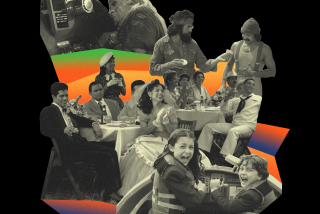‘Not to Be Missed’: A critic shares 54 favorite movies

- Share via
A book with the title of “Not to Be Missed: Fifty-Four Favorites From a Lifetime of Film” may seem straightforward enough. But to me that title raises all kinds of questions. Why such a book? Why 54 films, and what criteria were used to select them? And why, for that matter, become a film critic in the first place?
The answer to that, at least, should be obvious, though it’s often lost in the welter of unhappy reviews the nature of the job mandates. I became a critic out of a deep passion for films and their ability to simultaneously do several things I love: take me out of this world and return me to it not only entertained but, if I am fortunate, with my emotions and my understanding enlarged. I look on the best of the movies I’ve seen as friends who’ve enriched my life. As director Werner Herzog said, a memorable film “sticks to you forever. It never leaves you. It becomes part of your existence.”
The Brownsville area of Brooklyn I grew up in the 1950s and early 1960s had more in common with the immigrant Jewish neighborhood of the 1920s and ‘30s Alfred Kazin describes in “A Walker in the City” than the epicenter of hipness the borough has become. I not only had no thought of being a film critic as a child, I had no idea the profession even existed. I was just a kid who enjoyed movies and saw them every chance I could, which was not as often as I liked.
Because my old-country father was uncompromisingly observant, the traditional Saturday matinees at my two local movie houses, the ornate pleasure dome that was the Loew’s Pitkin and the more proletariat Brandt’s Sutter, were open to me only if I was willing to risk his wrath, which was rare. That said, I do have a vivid memory of sneaking out to see a vibrant, cleft-chinned Kirk Douglas so bringing the title role of “Ulysses” to life in 1957 that I still have trouble visualizing the Homeric epic without him in it.
Since my theatrical attendance was limited, I was fortunate to come across “Million Dollar Movie,” a local television program that showcased older Hollywood features nightly on WOR-TV Channel 9. I did my watching alone, I formed my opinions alone, I talked to no one about what I had seen. I was in effect becoming a critic though I didn’t know it.
I left Brooklyn first to go to college at Swarthmore, then to study journalism at Columbia, where I took a seminar in film reviewing offered by Judith Crist, one of New York’s top critics. She was the first to make me believe I could do this work professionally, and, as anyone who ever met her knows, when Judith Crist spoke, you listened. And so the journey began.
When you love something you do it a lot, and over the decades since I started to take film seriously I’ve seen more thousands than I can count. Sometimes I feel a kinship with the seventysomething horseplayer quoted in handicapper Andrew Beyer’s classic “Picking Winners” who told Beyer, “Son, if I’d spent the time studying law books that I’ve put into the Racing Form, I’d probably be on the Supreme Court now.”
Compiling a list like this seems the logical culmination of all the watching and reviewing I’ve done since my first pieces appeared in the Washington Post (where I was a staff writer) and the Progressive magazine in the mid-1970s. Doing a big chunk of that work in Los Angeles has been especially gratifying. A friend once described my job as the equivalent of being “the anthracite critic for the Scranton Times,” and writing for such a knowledgable audience has been a challenge and a pleasure.
Writing about film has been a voyage of discovery with two interlocking purposes: I write to be, to borrow Maimonides’ wonderful title, a guide for the perplexed, to help viewers find films they will love, but writing reviews soon became more than that. Through thinking long and hard about what I liked and disliked, it gradually became a process of finding out what was important to me on a broader scale. A way to find out, in short, just who I am.
Being useful as a reviewer always came first, however, and has always been the central element in how I view what I do. I took a course in the New Testament at Swarthmore, where I was told that the word “gospel” meant good news and referred specifically to the notion of spreading the good news about Jesus. It has struck me since that spreading the good news about films that were worth a viewer’s time was a goal worth having for a critic.
Similarly, it was the drive to have my book be of use that convinced me not to go the maximalist “one thousand films to see before you die” route and instead keep the number chosen much more manageable. Like anti-tax zealot Grover Norquist, eager to make government small enough to drown in a bathtub, I wanted my list small enough so that even a busy person like Mr. Norquist could reasonably decide to see them all if he or she so chose. Something in the 50s felt right.
With thousands of films to chose from, getting the list to just 54 was challenging. I’d fallen in love so often in the movies, embraced so many films that appealed to a variety of diverse moods, I felt like a cinematic Casanova forced to decide among multiple passions.
While I didn’t want to disappoint or even anger those who found their favorites absent — believe me, it has already started to happen, even in my own house — this selection of films couldn’t be helpful to others if I wasn’t true to myself. So I resisted the impulse to artificially present myself as the most ecumenical of critics, someone whose favorites casually extended to the farthest corners of the globe.
If more of the films I loved came from the studio system than elsewhere, if I had a pronounced passion for French cinema and film noir, if I found room for a trio of inside Hollywood films (“Bombshell,” “Singin’ In the Rain” and “Sunset Boulevard”) but somehow left off justifiably popular items like “Star Wars” that I truly enjoyed, it would just have to be that way.
All that said, I took it as a good sign that my list ended up striking something of a balance between films like “Casablanca” and “The Godfather” that everyone will have seen and those like “First Contact” and “Leolo” that have a more limited following. I re-saw each one before writing an accompanying essay, and made sure each one fit a specification Roger Ebert once laid down: “Every great film,” he wrote, “should seem new every time you see it.”
If writing reviews has been a gradual process of finding out who I am and what is important to me, putting this book together was akin to undertaking a spiritual autobiography, a way to make explicit what has been implicit for all these years. As even a glance at the list will tell you, I am a romantic (if pressed for my top film, I invariably pick “Children of Paradise”), I believe moral choices can be as exciting as the ones in thrillers, but more than that I am, for better or worse, a classicist. I trust in the traditional values of character development and story, and I still have faith in the notion of film as a popular art, emphasis on both words, a conviction that the greatest films ever made can be accessible to the widest of audiences.
Which leaves only the question, why 54 films? Once I decided on a number in the 50s, 54 came into my mind for what seemed like no particular reason. But as soon as I mentioned the number to UCLA history department chairman David Myers, he immediately said, “three times chai,” and I knew at once that that was exactly the reason I’d gravitated toward 54.
Chai is not only the Hebrew number 18, it is also the word for “life” (as in the traditional toast L’chaim, to life), so any multiple of 18 is considered to be a lucky number. I strongly believe I’ve been fortunate to be in a line of work that allows me to experience more movies than a sane person would attempt, and my book is my way of sharing that good fortune with the wider world. With any kind of luck, these films that have rewarded me enormously will bring you the same measure of pleasure and pure joy. I don’t believe movies get any better than this, and I hope you agree.
Below is Kenneth Turan’s list of 54 films “Not to Be Missed.” Find synopses, trailers and photos here.
In the Beginning
“Fantomas” — 1913-14
Silent comedy double feature:
“Sherlock Jr.” — 1924; and “Pass the Gravy” — 1928
The ‘30s
“I Am a Fugitive From a Chain Gang” — 1932
“Bombshell” —1933
“The Dybbuk” — 1937
Leo McCarey double feature:
“Make Way for Tomorrow” — 1937; and “Love Affair” — 1939
The ‘40s
“Pride and Prejudice” — 1940
“The Lady Eve” — 1941
“The Strawberry Blonde” — 1941
“Casablanca” — 1942
“Random Harvest” —1942
“Children of Paradise” — 1945
“Great Expectations” — 1946
“Bicycle Thieves” — 1948
“The Third Man” — 1949
Ernst Lubitsch double feature:
“The Shop Around the Corner” — 1940; and “To Be or Not to Be” — 1942
The ‘50s
“All About Eve” — 1950
“The Asphalt Jungle” — 1950
“Sunset Boulevard” — 1950
“Casque d’Or” — 1952
“The Importance of Being Earnest” — 1952
“Singin’ in the Rain” — 1952
“The Earrings of Madame de ...” — 1953
“Seven Samurai” — 1954
“Kiss Me Deadly” — 1955
“Seven Men From Now” — 1956
“Sweet Smell of Success” — 1957
“Vertigo” — 1958
The ‘60s
“The Man Who Shot Liberty Valance” — 1962
“The Gospel According to St. Matthew” — 1964
“Point Blank” — 1967
“Le Samourai” — 1967
“Kes” — 1969
The ‘70s
“The Godfather” — 1972
“Chinatown” — 1974
The ‘80s
“The Day After Trinity” — 1981
“First Contact” — 1982
“Distant Voices, Still Lives” — 1988
The ‘90s
“Howards End” — 1992
“Leolo” — 1992
“Unforgiven” — 1992
The New Century
“Spirited Away” — 2001
“The Best of Youth” — 2003
“The Five Obstructions” — 2003
“A Prophet” — 2009
“Of Gods and Men” — 2010
“Footnote” — 2011
Documentary double feature:
“Stranded” — 2007; and “Senna” — 2010
Orson Welles double feature:
“Touch of Evil” — 1958; and “Falstaff”/”Chimes at Midnight” — 1965
The above essay is adapted from “Not to Be Missed: Fifty-Four Favorites From a Lifetime of Film,” being published in June by Public Affairs.
More to Read
Only good movies
Get the Indie Focus newsletter, Mark Olsen's weekly guide to the world of cinema.
You may occasionally receive promotional content from the Los Angeles Times.











